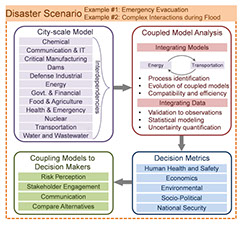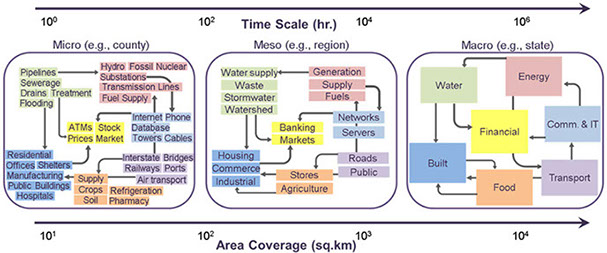Research

Overarching Theme
The NRT’s DESE theme points to the need for scientific knowledge and data of natural and engineered systems to be combined to maximize our understanding and therefore reach informed decisions. Hence, our core research questions in this project are: “How can vulnerabilities be identified from data and models for critical, interdependent infrastructure systems?” and “Can we predict and moderate the impacts of system failures on society if these vulnerabilities are identified?” We aim to improve the fundamental understanding of vulnerability issues associated with infrastructure systems in general; however, we have a specific focus on the critical, interdependent systems identified by the Department of Homeland Security (see Figure 1 on Vision page for a partial representation of these infrastructure systems).
Our research theme comprises three core model engineering and data science areas:
- integrating models to models
- incorporating data into models, and
- communicating model predictions to the decision makers.
Each area will allow us to highlight key model/data science issues, understand how these issues translate to societal impacts caused by vulnerabilities in infrastructure systems, and develop solutions to mitigate the damage causing potential of the vulnerabilities. Within our three areas, we have broken out tasks to systematically address our major research questions associated with the integrated modeling of interdependent systems.
Task 1: Integrating Models to Models
Process Identification in Model Integration for Vulnerability Assessment
How detailed should our models be? This is a key question for modeling in all scientific fields, but it becomes especially critical for model integration where it can be unclear which models and feedback mechanisms to include within integrated models such that they reveal emergent behaviors that could reveal infrastructure vulnerabilities of interest. These questions are difficult to answer a priori. What is more, the processes that cause the feedback mechanisms are often poorly understood, further complicating the problem. Traditional modeling approaches also present a roadblock to the problem, as the models are not developed to allow easy revisions to incorporate new details or information. Once the processes and structure of a model have been identified and developed for a particular scenario—the model is used for a specific analysis and no longer continues to change. However, allowing for dynamic and constant evolution of the underlying model components, processes, and structures (i.e., beyond the updating of the parameters in a Bayesian sense) could potentially address the difficulties in determining the needed details in integrated models.
To address these challenges, we propose to take a multi-faceted approach combining (1) heuristics based on frameworks such as NIST’s Community Resilience Guidelines, which can help guide model engineers to more fully consider mappings to system components that may otherwise be neglected; (2) our understanding of local communities, gained through community engagement; and (3) mathematical representations that will help us identify which heuristics are meaningful in the context of the system using indicator functions to link categorical and quantitative data in combination with sensitivity analysis to identify influential factors. We aim to develop a framework to shift our focus from modeling individual elements of infrastructure to understanding how the disparate components of a system can be progressively brought together, particularly when emergent phenomena are important. Lastly, we propose to develop a new approach that will allow models to organically learn and evolve as more information becomes available.
Extensibility of Infrastructure System Models
How can we progressively extend our models? The answer to this question involves methods and practices for modularity, reusability, and interoperability of models representing different infrastructure components to “fit together” (much like Lego blocks) to form the full system. This approach is particularly attractive for our project, as it will allow PROACTIVE students to integrate their models, promoting collaborations and equipping them with the ability to gradually extend their models (by coupling their models to one another) while exercising their interdisciplinary communication skills through collaborative activities. For this, we aim to build an architecture that promotes direct linkage and reuse of modeling components from different disciplines where the conceptualization, mechanisms, and language of science may differ greatly. Traditional approaches that couple models are based on shared parameters. We are well-versed in these traditional approaches and propose to further our work by building upon the advances in ontologic and semantic data modeling to develop more flexible interfaces that preserve the rigor of the traditional coupling algorithms. These issues are particularly challenging for coupled infrastructure system models, in which there is a range in the degree of model “quantitativeness.” We will also need to enhance model efficiency, perhaps through the use of hierarchical methods that provide flexibility in selection of what models to run and when they should be run. For example, our approach will allow simplified models to replace computationally intensive ones in certain scenarios or a fast model to run many times to explore uncertainty space around the conditions calculated for a slower-running model.
Task 2: Incorporating Data to Models
Validation and Uncertainty Quantification of Integrated Models
When is a model good enough? This is a fundamental question that challenges all modeling efforts but is amplified when models are reused in a variety of integration scenarios to identify vulnerabilities for interdependent infrastructure systems. This is because the information content of data for integrated models may not be easily determined, given that the mapping between data and parameters may be indirect and often uncertain. Furthermore, non-linearity and the potential for chaotic behaviors can make results difficult to generalize, as system behavior becomes strongly dependent on initial conditions. Given the difficulty with fitting data from multiple systems simultaneously, we may, for instance, focus our efforts on multi-objective optimization techniques. We have already started to evaluate the use of existing, mature model validation and uncertainty quantification methodologies to assess their efficacy for integrated models. We propose to expand our existing statistically rigorous capabilities for tracing the propagation of uncertainties and errors between models during integration to accommodate models with varying degrees of “quantitativeness.”

Accounting for Spatial Variability in Integrated Models
How to handle spatial variability? Capturing the behavior of large-scale, spatially distributed systems with multiple coupled processes is a modeling challenge in itself. The computational requirements for fine-scale modeling of these systems at the regional or continental scales are beyond our current computational abilities. Yet both local and national policy makers must understand the behavior of our natural and built infrastructures across these scales to make informed decisions about how to develop and regulate these systems. We propose to develop methods that can enhance the efficiency of models across the many scales at which complex systems operate. Multi-scale modeling methods are one clear approach, but we need to develop approaches to determine the optimal choice of scales when the system is uncertain or poorly defined as well as when critical processes occur across fundamentally different scales. To answer these questions, we may use data-driven decomposition and model reduction techniques to capture spatiotemporal patterns to improve our ability to model risk and resiliency in natural, built, and socioeconomic infrastructure systems. With this approach, we can evaluate transformations of data and models to sparse representations to facilitate the integration of heterogeneous data sources to couple the properties, processes, and forcing of coupled systems across scales (Figure 2, above).
Task 3: Communicating Model Predictions to the Decision Makers
Closed-loop Communication Among Models, Modelers, and Decision Makers
How to best link models with stakeholders? We have identified three major components in linking model predictions to stakeholders:
- specific output information from the model to the decision makers (e.g., flooding predictions, blackout probabilities, extent of potential infrastructure damage, repair costs, etc.);
- data regarding the model itself (e.g., prediction uncertainties, underlying assumptions, model limitations, initial/boundary conditions, robustness against those assumptions and limitations); and
- the class of information that flows from the decision makers/stakeholders to the modeler: (e.g., values, priorities, limitations (economic, political, social), etc.). Effective use of model information for closed-loop communication requires that the modelers take into account the cognitive schemata, decision processes (especially heuristics and biases), cognitive limitations, etc. of the decision makers and, if possible, incorporate these into the models themselves.
We propose to establish a framework for thoroughly documenting the modeling process, and communicating the uncertainties and errors associated with model predictions in ways that will maximize the likelihood of information being used effectively. The framework will take into account the range of decision makers and stakeholders’ values, priorities, and levels of expertise and effectively inform the decision makers of the options, costs, and benefits as well as the risks associated with each course of action, as they must be informed about the robustness of their decision in the face of hard-to-control factors.
Incorporation of Human Perceptual and Decision Processes
How to include human judgment in infrastructure models? Two different decision makers provided with the same model predictions can reach decisions entailing vastly different actions with vastly different probabilities of success. These differences stem, in large part, from the decision makers’ perceptions of the model’s predictions, assumptions, and the associated errors and uncertainties. We propose to identify suitable mechanisms to incorporate models of human risk perception and decision making into predictive models of infrastructure management. Models of human judgment (e.g., prescriptive models such as subjective expected utility and/or descriptive models such as cognitive heuristics or recognition-primed decision making) are likely appropriate candidates for inclusion into integrated simulation models of infrastructure systems. Infrastructure models and human cognitive models should be made sufficiently compatible to couple without losing the essential and critical elements/features of each. We will implement both a “top-down” (incorporate rigorous evidence-based models of human risk perception and decision making) approach and a “bottom-up” (engage decision makers and stakeholders in the process from the beginning) approach.


